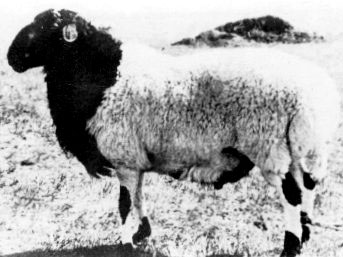Ujumqin Sheep
 The Ujumqin, a larger version of the Mongolian, is found in Inner Mongolia, China.
It has a fat tail 28 cm long by 36 cm wide in the male, and 22 cm long by 28 cm wide
in the female. When dressed, the tail fat weighs 2 kg or more.
The Ujumqin, a larger version of the Mongolian, is found in Inner Mongolia, China.
It has a fat tail 28 cm long by 36 cm wide in the male, and 22 cm long by 28 cm wide
in the female. When dressed, the tail fat weighs 2 kg or more.
These sheep have a type of coarse wool commonly called "carpet wool." They are adapted to the unfavorable local environmental conditions of the North and Northwest Pastoral Grasslands. The Ujumqin have the ability to deposit fat in the tail (fat-tail sheep). Wool production is low, with an annual grease fleece weight of only about 1 kg.
 The Ujumqin was developed due to the sharp seasonal contrast in plant growth in the
pastoral areas. The sheep tend to deposit a large amount of fat in the body in order
to meet nutritional demands during winter and spring. In addition, the herdsmen working
under those rigorous climatic conditions need fat as the main source of energy supply,
and so have selected towards sheep with high fat deposits. These two factors, natural
as well as artificial selection, were presumably responsible for the development of
the fat-tail sheep on the pastoral grasslands in the north and northwest.
The Ujumqin was developed due to the sharp seasonal contrast in plant growth in the
pastoral areas. The sheep tend to deposit a large amount of fat in the body in order
to meet nutritional demands during winter and spring. In addition, the herdsmen working
under those rigorous climatic conditions need fat as the main source of energy supply,
and so have selected towards sheep with high fat deposits. These two factors, natural
as well as artificial selection, were presumably responsible for the development of
the fat-tail sheep on the pastoral grasslands in the north and northwest.
References
Cheng, P. (1984) Livestock breeds of China. Animal Production and Health Paper 46 (E, F, S). Publ. by FAO, Rome, 217 pp.
Mason, I.L. World Dictionary of Livestock Breeds. Third Edition. C.A.B International. 1988
